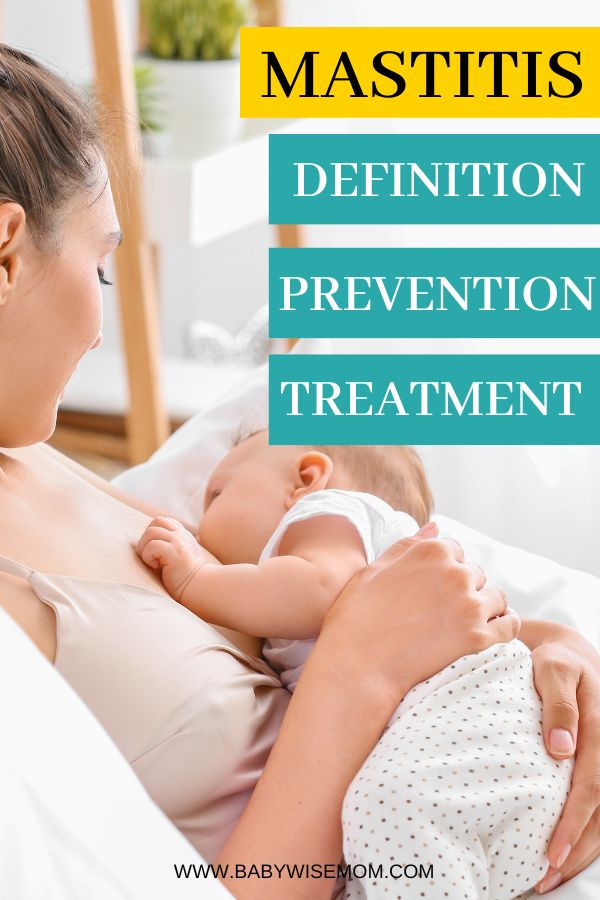Mastitis is a painful infection of the breast that can happen while you are breastfeeding. Find out more about what Mastitis is, how to prevent it, and how to treat it if you get it.

Mastitis is an infection in your breast. I, unfortunately, have plenty of experience with mastitis.
The first time I had mastitis, Brayden was about 3-4 weeks old. I didn’t feel well, but I was coming on several weeks of not sleeping much. My breasts hurt, but breastfeeding had been pretty painful thus far.
One day I looked in the mirror to see that my breast was very red. At that point, I had some distant memory come up about what I had read about mastitis.
I also got it when Kaitlyn was two weeks old, and sometime when McKenna was a young baby. At this point, Brinley is almost 7 months old and I have not gotten it–knock on wood!
Here is some basic information on mastitis. I am obviously not a doctor–this is just my understanding and experience.
If you think you have mastitis, definitely consult your doctor. Mastitis left untreated can lead to serious problems.
Post Contents
DEFINITION of MASTITIS
Mastitis is an infection in the breast. Mastitis can happen at any time (even if you are not breastfeeding, though it is most common when breastfeeding).
It most frequently happens early in breastfeeding. You will typically get it in just one breast–so one will be much more painful than the other.
MASTITIS SYMPTOMS
Symptoms include:
- Fatigue
- Pain in breast
- Redness and swelling of breast–it will likely feel hot
- Flu-like symptoms
- Fever–101 or higher
MASTITIS TREATMENT
Call your doctor as soon as you know or even think you have mastitis.
My first OBGYN was very adamant about seeing you immediately if you had mastitis. Mastitis left untreated will most likely lead to a serious problem that requires surgery to relieve the abscess that forms.
My OBs sister had this happen. She got so sick it was scary, so he really wanted to prevent it from happening to someone else.
Your OBGYN will likely want to see you physically unless this is not your first time getting mastitis. If mastitis is confirmed, you will be put on oral antibiotics.
You can also take a pain reliever to help with the fever and pain. You should feel better really soon–a day or two. I highly recommend you also take some sort of probiotic to help avoid developing thrush (AKA yeast) in your breast.
If you think you have or may be headed toward mastitis, you can work to unclog the duct (see below). If it is mastitis that is simply started by a clogged duct and doesn’t have any bacteria (yet), then you might be able to clear it out by clearing the ducts.
You can also try natural remedies (just google mastitis natural remedies and you will find plenty) If you have had symptoms for more than a day, though, or if your fever is above 101, I strongly suggest you go to the doctor.
FEEDING BABY WHEN YOU HAVE MASTITIS
You can absolutely continue breastfeeding your baby when you have mastitis. It is wise to start each feeding on the infected breast until the clog is gone.
CAUSES of MASTITIS
Mastitis is caused by a clogged duct and/or bacteria.
If you get a clogged duct and don’t resolve it, it will likely lead to mastitis.
I always get clogged ducts early in the breastfeeding process. Work really hard to get those ducts unclogged! You don’t want to get mastitis in your breasts.
It can really hurt to work out the clogged duct, but it is much better than letting it lead to mastitis (and for me, the almost inevitable yeast infection that follows the antibiotics).
Mastitis can also be caused by bacteria–often from your baby’s mouth entering through a crack in your nipple.
You can see why mastitis is often an early breastfeeding issue–this is when you have an overabundance of milk and your nipples are building callouses.
PREVENTING MASTITIS
“They” say that you are either the type to get mastitis or to not get it. I had accepted this, but with Brinley, I had a change of fate.
When I was in the hospital the day after she was born, a different OB came to see me in the morning (mine was off work). She mentioned something about mastitis and I causally commented that I always get mastitis.
She suggested that I use Newman’s Nipple Cream to help avoid getting it this time. This was the first time I entertained the idea that I could possibly avoid mastitis. Here are some ways to prevent this:
- Wear a loose enough bra so your milk ducts are not compressed–this can lead to clogged ducts. Do this especially in your first few weeks of breastfeeding while your body figures out how much milk to make.
- Drink plenty of fluids.
- Prep your nipples before childbirth so they do not crack. I had great success with regularly applying lanolin during my third trimester. I didn’t crack when I started breastfeeding because I wasn’t so incredibly dry.
- Heal your nipples. This is one great thing about Newman’s Nipple Cream (this requires a prescription). It has a steroid in it, so it helps your cracked nipples heal faster. You can also use a nipple shield if you would like to while you have cracked nipples. This will help protect against bacteria. Newman’s Nipple Cream also has an antibacterial agent in it, so it will help fight against bacteria getting in.
- Keep ducts clear. There are many ways to go about this. If you get a clogged duct, start each feeding on that side. You can also vary nursing positions to help drain different portions of the breast.
You can also do some pumping between feedings to relieve pressure. I didn’t do this with my first three children because I wanted my body to get used to how much milk really was needed. However, I found with Brinley I could pump a little bit and take the edge off and then just slowly cut down on how much I pumped. Pumping can be annoying, but I assure you that it is far less annoying than mastitis.As your baby eats, gently massage the clogged duct. I apply pressure and press toward the nipple. This hurts like crazy, but if you work the clog out, it will feel better in a couple of hours. It will, however, still be tender.You can also apply warm compresses or run warm water over the affected breast. Again, rub the clog out and toward the nipple. I found this the most helpful in relieving clogs. I just continued massaging until the clog was gone.
See also How I Breastfed for 12 Months Even When Everything Went Wrong
CONCLUSION
Mastitis is not fun. Do what you can to avoid it. If you do get it, check with your doctor to see if it needs to be treated.
Reader Questions
- sasa said…
Thanks for your advice! He finally slept through the night last night, so it must have been the calorie thing– two meals just might be my answer! Hopefully, it will continue. I’m looking forward to reading more of your blog. Any help for a breast infection? Or maybe it’s a clogged duct? Must have come on because of the lack of sleep the last two weeks!
Babywise Mom said…
Really watch the infection. I have had mastitis twice. The first time kind of caught be by surprise. The second time I knew it was coming before it got bad. I would start each nursing session on the side that is clogged until it clears up. You can also massage the spot while nursing to help get it out. If it gets really tender, red, or hot or if you feel flu-like symptoms, call your doctor right away. Mastitis can be really serious if left untreated.

